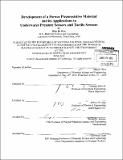Development of a porous piezoresistive material and its applications to underwater pressure sensors and tactile sensors
Author(s)
Woo, Mun Ee
DownloadFull printable version (14.07Mb)
Other Contributors
Massachusetts Institute of Technology. Department of Materials Science and Engineering.
Advisor
Vladimir Bulović and Jeffrey H. Lang.
Terms of use
Metadata
Show full item recordAbstract
MEMS (Microelectromechanical System) pressure sensor arrays are gaining attention in the field of underwater navigation because they are seen as alternatives to current sonar and vision-based systems that fail to navigate unmanned undersea vehicles (UUVs) in dark, unsteady and cluttered environments. Other advantages of MEMS pressure sensor arrays include lower power consumption and that their passive nature makes them covert. The goal of this work focuses on the development of a flexible pressure sensor array for UUVs, where the sensor array is inspired by the ability of fish to form three-dimensional maps of their surroundings. Fish are able to decipher various pressure waves from their surroundings using the array of pressure sensors in their lateral line sensory organs that can detect minute pressure differences. Similarly, by measuring pressure variations using an engineered pressure-sensor array on the surface of an UUV, this project hopes to aid UUVs in the identification and location of obstacles for navigation. The active material of the pressure sensor array is a porous polydimethylsiloxane (PDMS)-carbon black composite made out of a sugar sacrificial scaffold that shows great promise for satisfying the proposed applications. The proposed device structure is flexible, easily fabricated, cost efficient and can be implemented on a large-area and curved UUV surface. Although hysteresis occurs during the electromechanical test, the piezoresistivity of this porous PDMS-carbon black composite is reversible and reproducible. Compared to its non-porous counterpart, this porous composite shows a six-times increase in piezoresistivity and a greatly reduced Young's Modulus. When tested underwater, this porous composite was able to differentiate water waves that had a frequency of 1 Hz and 2 Hz, which is promising for its underwater application. This porous composite was also extended to the application of tactile sensors using a different device architecture, which showed excellent response under mechanical testing.
Description
Thesis (S.M.)--Massachusetts Institute of Technology, Dept. of Materials Science and Engineering, 2013. Cataloged from PDF version of thesis. Includes bibliographical references (p. 82-86).
Date issued
2013Department
Massachusetts Institute of Technology. Department of Materials Science and EngineeringPublisher
Massachusetts Institute of Technology
Keywords
Materials Science and Engineering.